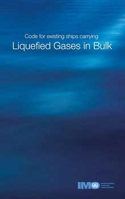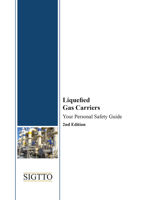Published: January 2022
This title offers comprehensive detail on the bulk transport at sea of liquefied petroleum gas (LPG), liquefied natural gas (LNG) and chemical gases, as well as aspects of various cargo handling systems. It includes a chapter on cargo calculations, ensuring ships’ crew are aware of correct loading quantities prior to cargo operations.
This book provides an assessment of gases, including their hazards and properties, before considering all stages of LPG and LNG operations. A detailed overview of STS operations is also included.
Processes such as reliquefaction and gassing-up are illustrated by 3D models, a beneficial visual aid to those in preparation and operation of modern gas carrying ships, or in operation of a related shore facility. The guidance concludes with a consideration of general emergency procedures, including the principal hazards on gas carriers.
Contents:
Acknowledgements
Foreword
Introduction
1. The Gases and Their Properties
1.1 Introduction
1.2 Chemical Properties of the Gases
1.3 Physical Properties of the Gases
1.4 Gases – Properties and Rules
1.5 States of Matter
1.6 What are the Gases Carried on Liquefied Gas Carriers Used For?
2. Potential
2.1 Health Hazards
2.2 Flammability and Explosion
2.3 O2 Concentration and Inerting
2.4 Sources of Ignition
3. Ship Characteristics and Cargo
3.1 Principles of Gas Carrier Design and Construction and the IGC Code
3.2 Cargo Containment Systems
3.3 Materials of Construction
3.4 Hold Spaces
3.5 Liquefied Gas Carriers – Ship Types
3.6 General Gas Carrier
3.7 Layout Surveys and Certification
4. Regulations, Codes and Guidance for Gas
4.1 The IGC Code
4.2 International Convention for the Safety of Life at Sea (SOLAS)
4.3 International Convention for the Prevention of Pollution from Ships (MARPOL)
4.4 International Convention on Standards of Training, Certification and Watchkeeping for Seafarers (STCW)
4.5 Other Conventions and Codes
4.6 Inter-Industry Organisations
4.7 Classification Societies
4.8 Ship Inspection
5. Cargo Handling
5.1 Cargo Piping, Valves and Auxiliary Systems
5.2 Pressure Relief Valves (PRVs)
5.3 Cargo Pumps
5.4 LPG Reliquefaction
5.5 LNG Reliquefaction
5.6 Inert Gas Systems
5.7 Electrical Equipment in Hazardous Areas
5.8 Instrumentation
5.9 Custody Transfer Measurement System (CTMS)
6. LPG
6.1 Drying
6.2 Inerting
6.3 Gassing-up
6.4 Cooldown
6.5 Loading
6.6 Loaded Passage
6.7 Discharge
6.8 Ballast Passage
6.9 Changing Grades/Gas
6.10 Freeing Aeration of Cargo Tanks
6.11 Important Points When Changing Liquefied Gas Cargoes
6.12 Tank Cleaning Table Liquefied Gas (Fully Refrigerated LPG)
6.13 Change of Cargo Table
6.14 Odourisation (Stenching)
6.15 Mixing Cargoes (Blending/Co-mingling)
7. LNG
7.1 Normal Trading Cycle of an LNGC
7.2 Operations Related to Auxiliary Systems
7.3 Drying
7.4 Inerting
7.5 Gassing-up
7.6 Cooldown
7.7 Loading Operation
7.8 Laden Voyage
7.9 Discharge Operation
7.10 Ballast Voyage
8. Ship to Ship (STS)
8.1 Pre-arrival Stage
8.2 Approach and Mooring Stage
8.3 Cargo Transfer Stage
8.4 Post-transfer Procedure
9. Cargo
9.1 Principle
9.2 Weight or Mass
9.3 Density
9.4 Temperature
9.5 Pressure
9.6 ASTM Tables
9.7 Total Weight of Liquid Cargo
9.8 Total Weight of Vapour Cargo
9.9 Discharging Calculations
9.10 Cargo Calculation Form
9.11 Vessel Experience Factors
10. Terminal
10.1 The Ship/Shore Interface
10.2 Communications
10.3 Pre-arrival
10.4 General Precautions While the Ship is at Berth
10.5 Cargo Handling
10.6 Cargo Vapour Handling
10.7 Additional Procedures
11. Safe Practices and Safety
11.1 Tank Atmosphere Evaluation
11.2 Fixed Gas Detection
11.3 Portable and Personal Gas Detection
11.4 Entry into Enclosed Spaces
11.5 Respiratory Protection Used on Liquefied Gas Carriers
12. Emergency
12.1 The Principal Hazards
12.2 Fire Protection and Fire Extinguishing
12.3 Emergency Procedures
12.4 Emergency Plans
Annex
Annex 1 – Bibliography
Annex 2 – Useful Formulae and Notes
Index
Acknowledgements
Foreword
Introduction
1. The Gases and Their Properties
1.1 Introduction
1.2 Chemical Properties of the Gases
1.3 Physical Properties of the Gases
1.4 Gases – Properties and Rules
1.5 States of Matter
1.6 What are the Gases Carried on Liquefied Gas Carriers Used For?
2. Potential
2.1 Health Hazards
2.2 Flammability and Explosion
2.3 O2 Concentration and Inerting
2.4 Sources of Ignition
3. Ship Characteristics and Cargo
3.1 Principles of Gas Carrier Design and Construction and the IGC Code
3.2 Cargo Containment Systems
3.3 Materials of Construction
3.4 Hold Spaces
3.5 Liquefied Gas Carriers – Ship Types
3.6 General Gas Carrier
3.7 Layout Surveys and Certification
4. Regulations, Codes and Guidance for Gas
4.1 The IGC Code
4.2 International Convention for the Safety of Life at Sea (SOLAS)
4.3 International Convention for the Prevention of Pollution from Ships (MARPOL)
4.4 International Convention on Standards of Training, Certification and Watchkeeping for Seafarers (STCW)
4.5 Other Conventions and Codes
4.6 Inter-Industry Organisations
4.7 Classification Societies
4.8 Ship Inspection
5. Cargo Handling
5.1 Cargo Piping, Valves and Auxiliary Systems
5.2 Pressure Relief Valves (PRVs)
5.3 Cargo Pumps
5.4 LPG Reliquefaction
5.5 LNG Reliquefaction
5.6 Inert Gas Systems
5.7 Electrical Equipment in Hazardous Areas
5.8 Instrumentation
5.9 Custody Transfer Measurement System (CTMS)
6. LPG
6.1 Drying
6.2 Inerting
6.3 Gassing-up
6.4 Cooldown
6.5 Loading
6.6 Loaded Passage
6.7 Discharge
6.8 Ballast Passage
6.9 Changing Grades/Gas
6.10 Freeing Aeration of Cargo Tanks
6.11 Important Points When Changing Liquefied Gas Cargoes
6.12 Tank Cleaning Table Liquefied Gas (Fully Refrigerated LPG)
6.13 Change of Cargo Table
6.14 Odourisation (Stenching)
6.15 Mixing Cargoes (Blending/Co-mingling)
7. LNG
7.1 Normal Trading Cycle of an LNGC
7.2 Operations Related to Auxiliary Systems
7.3 Drying
7.4 Inerting
7.5 Gassing-up
7.6 Cooldown
7.7 Loading Operation
7.8 Laden Voyage
7.9 Discharge Operation
7.10 Ballast Voyage
8. Ship to Ship (STS)
8.1 Pre-arrival Stage
8.2 Approach and Mooring Stage
8.3 Cargo Transfer Stage
8.4 Post-transfer Procedure
9. Cargo
9.1 Principle
9.2 Weight or Mass
9.3 Density
9.4 Temperature
9.5 Pressure
9.6 ASTM Tables
9.7 Total Weight of Liquid Cargo
9.8 Total Weight of Vapour Cargo
9.9 Discharging Calculations
9.10 Cargo Calculation Form
9.11 Vessel Experience Factors
10. Terminal
10.1 The Ship/Shore Interface
10.2 Communications
10.3 Pre-arrival
10.4 General Precautions While the Ship is at Berth
10.5 Cargo Handling
10.6 Cargo Vapour Handling
10.7 Additional Procedures
11. Safe Practices and Safety
11.1 Tank Atmosphere Evaluation
11.2 Fixed Gas Detection
11.3 Portable and Personal Gas Detection
11.4 Entry into Enclosed Spaces
11.5 Respiratory Protection Used on Liquefied Gas Carriers
12. Emergency
12.1 The Principal Hazards
12.2 Fire Protection and Fire Extinguishing
12.3 Emergency Procedures
12.4 Emergency Plans
Annex
Annex 1 – Bibliography
Annex 2 – Useful Formulae and Notes
Index
Acknowledgements
Foreword
Introduction
1. The Gases and Their Properties
1.1 Introduction
1.2 Chemical Properties of the Gases
1.3 Physical Properties of the Gases
1.4 Gases – Properties and Rules
1.5 States of Matter
1.6 What are the Gases Carried on Liquefied Gas Carriers Used For?
2. Potential
2.1 Health Hazards
2.2 Flammability and Explosion
2.3 O2 Concentration and Inerting
2.4 Sources of Ignition
3. Ship Characteristics and Cargo
3.1 Principles of Gas Carrier Design and Construction and the IGC Code
3.2 Cargo Containment Systems
3.3 Materials of Construction
3.4 Hold Spaces
3.5 Liquefied Gas Carriers – Ship Types
3.6 General Gas Carrier
3.7 Layout Surveys and Certification
4. Regulations, Codes and Guidance for Gas
4.1 The IGC Code
4.2 International Convention for the Safety of Life at Sea (SOLAS)
4.3 International Convention for the Prevention of Pollution from Ships (MARPOL)
4.4 International Convention on Standards of Training, Certification and Watchkeeping for Seafarers (STCW)
4.5 Other Conventions and Codes
4.6 Inter-Industry Organisations
4.7 Classification Societies
4.8 Ship Inspection
5. Cargo Handling
5.1 Cargo Piping, Valves and Auxiliary Systems
5.2 Pressure Relief Valves (PRVs)
5.3 Cargo Pumps
5.4 LPG Reliquefaction
5.5 LNG Reliquefaction
5.6 Inert Gas Systems
5.7 Electrical Equipment in Hazardous Areas
5.8 Instrumentation
5.9 Custody Transfer Measurement System (CTMS)
6. LPG
6.1 Drying
6.2 Inerting
6.3 Gassing-up
6.4 Cooldown
6.5 Loading
6.6 Loaded Passage
6.7 Discharge
6.8 Ballast Passage
6.9 Changing Grades/Gas
6.10 Freeing Aeration of Cargo Tanks
6.11 Important Points When Changing Liquefied Gas Cargoes
6.12 Tank Cleaning Table Liquefied Gas (Fully Refrigerated LPG)
6.13 Change of Cargo Table
6.14 Odourisation (Stenching)
6.15 Mixing Cargoes (Blending/Co-mingling)
7. LNG
7.1 Normal Trading Cycle of an LNGC
7.2 Operations Related to Auxiliary Systems
7.3 Drying
7.4 Inerting
7.5 Gassing-up
7.6 Cooldown
7.7 Loading Operation
7.8 Laden Voyage
7.9 Discharge Operation
7.10 Ballast Voyage
8. Ship to Ship (STS)
8.1 Pre-arrival Stage
8.2 Approach and Mooring Stage
8.3 Cargo Transfer Stage
8.4 Post-transfer Procedure
9. Cargo
9.1 Principle
9.2 Weight or Mass
9.3 Density
9.4 Temperature
9.5 Pressure
9.6 ASTM Tables
9.7 Total Weight of Liquid Cargo
9.8 Total Weight of Vapour Cargo
9.9 Discharging Calculations
9.10 Cargo Calculation Form
9.11 Vessel Experience Factors
10. Terminal
10.1 The Ship/Shore Interface
10.2 Communications
10.3 Pre-arrival
10.4 General Precautions While the Ship is at Berth
10.5 Cargo Handling
10.6 Cargo Vapour Handling
10.7 Additional Procedures
11. Safe Practices and Safety
11.1 Tank Atmosphere Evaluation
11.2 Fixed Gas Detection
11.3 Portable and Personal Gas Detection
11.4 Entry into Enclosed Spaces
11.5 Respiratory Protection Used on Liquefied Gas Carriers
12. Emergency
12.1 The Principal Hazards
12.2 Fire Protection and Fire Extinguishing
12.3 Emergency Procedures
12.4 Emergency Plans
Annex
Annex 1 – Bibliography
Annex 2 – Useful Formulae and Notes
Index







































